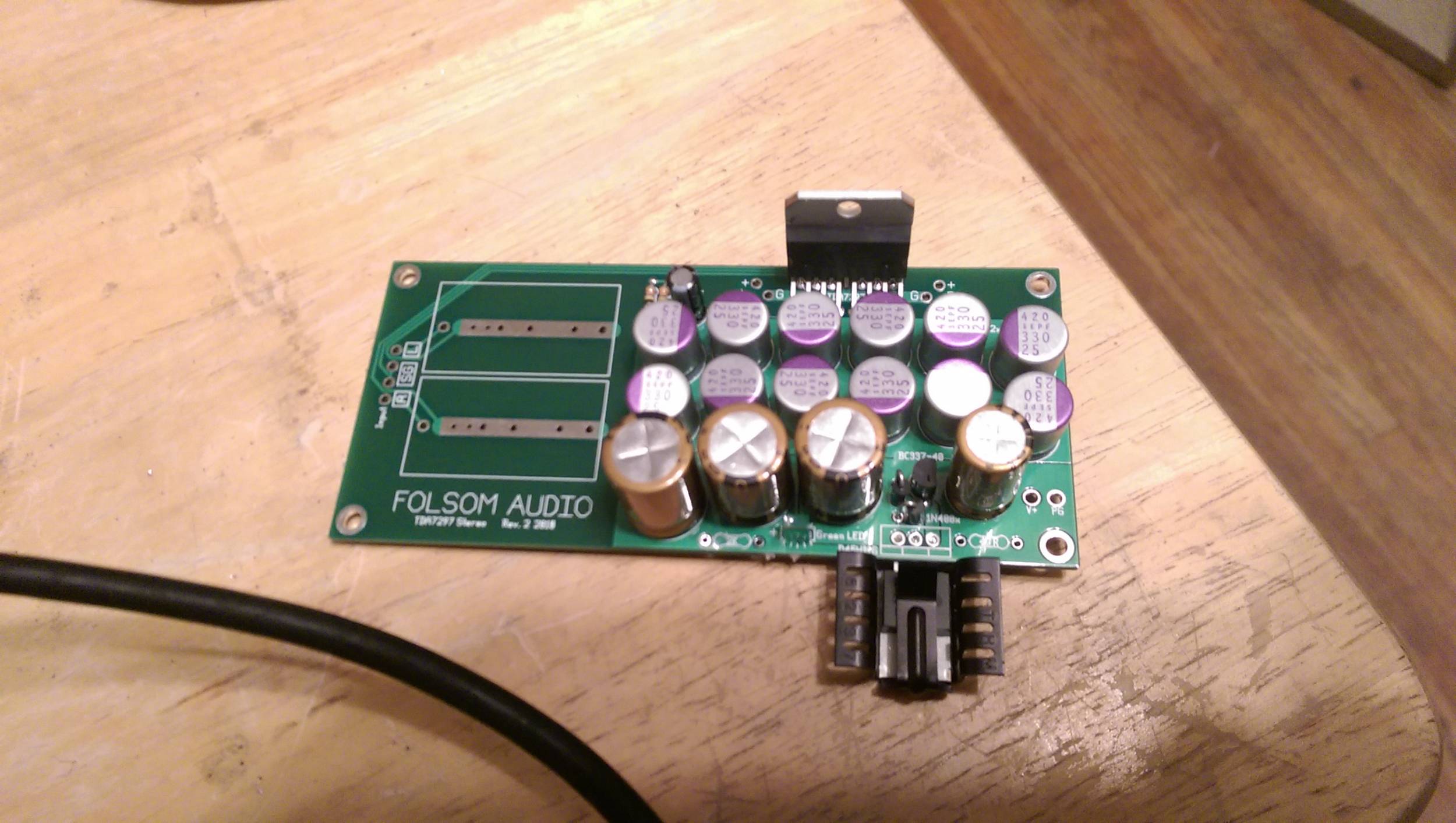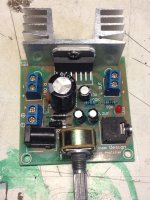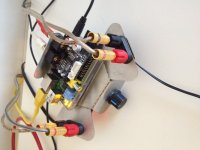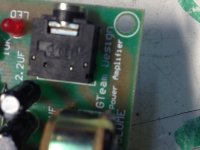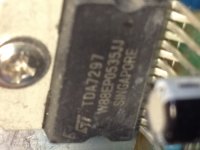Are these esd succeptable?
After waiting for 5 weeks, mine arrived looking good.
No sound during a quick test this morning, however, using one of the outputs.
Would the pot be the first item to suspect?
After waiting for 5 weeks, mine arrived looking good.
No sound during a quick test this morning, however, using one of the outputs.
Would the pot be the first item to suspect?
Well it turns out that the terminal marked + was connected to pin 8, pretty much the opposite of what it should have been.
Made some normal music until I went and bridged the input caps, swapped in better decoupling and bridged the diode, now it has a nasty hum, no music.
Hum goes away when the input connection to the pot is open, after un-doing the changes.
Made some normal music until I went and bridged the input caps, swapped in better decoupling and bridged the diode, now it has a nasty hum, no music.
Hum goes away when the input connection to the pot is open, after un-doing the changes.
16v is better, nice sound, doesn't blow up. The ST chips from mouser might actually take 20v on a very good heatsink. The China chips blow the **** up at like 18v.
SG and PG have to be connected at some point or you won't get any music. (signal and power ground)
SG and PG have to be connected at some point or you won't get any music. (signal and power ground)
I went and found a more rewarding project; a tiny car amp that uses two, mono ta7250bp amps, was a bargain find on the local classifieds. Works great on the 14v power supply I had put together while waiting for the $2 one.
It has no current limiting, dual mono, nice heat sink, and sounds really good, is ripe for some capacitor swapping and wiring upgrades.
The $2 amp is now at the bottom of my parts box, where it will stay until I either need an led, or a cheap volume pot...
It has no current limiting, dual mono, nice heat sink, and sounds really good, is ripe for some capacitor swapping and wiring upgrades.
The $2 amp is now at the bottom of my parts box, where it will stay until I either need an led, or a cheap volume pot...
16v is better, nice sound, doesn't blow up. The ST chips from mouser might actually take 20v on a very good heatsink. The China chips blow the **** up at like 18v.
SG and PG have to be connected at some point or you won't get any music. (signal and power ground)
Thanks, it's strange that - according to the st data sheet http://www.micropik.com/PDF/TDA7297-datasheet.pdf - distortion vs. output power 5W: 12V is about 1% ati 15khz, but with 16.5V 0.4% at 15khz (I think 5W should be enough to me).
They say that the Max. Total power dissipation is 35W, what does it mean for a 5W output?
I wouldn't worry about the dissipation figure. Put it on a good heatsink so you'll get the available power. You don't "need" more watts but available current capability is important and related.
I've really been working on getting this board to sound very good. It has some limitations, but thus far every step puts thing into a pretty stupendous sound. It's lively and with authority. Getting the refinement has been the big trick.
Right now I'm running a 10nf in series with 500ohm resistor right off my speaker terminals, parallel, and it made a very nice difference in the bass. The amp sinks too much current into the resonation of the speaker cable otherwise.
I've really been working on getting this board to sound very good. It has some limitations, but thus far every step puts thing into a pretty stupendous sound. It's lively and with authority. Getting the refinement has been the big trick.
Right now I'm running a 10nf in series with 500ohm resistor right off my speaker terminals, parallel, and it made a very nice difference in the bass. The amp sinks too much current into the resonation of the speaker cable otherwise.
works fine even with 4.5V or 5V. Nice smooth sound. How much is the "basic" tda7297 tuning package?
? Tuning package?
I've found out that it needs a zobel, and resonance dampening is ok on speaker cable. The bigger upgrade was using a balanced XLR cable so that the shield can be drained.
I've found out that it needs a zobel, and resonance dampening is ok on speaker cable. The bigger upgrade was using a balanced XLR cable so that the shield can be drained.
I mean, some replacements < 3-4 EUR in order to reduce distortions. Is it secure to run the tda7297 on 5V? I've tested it for some minutes: of course, the volume is lower, but I haven't notived any clipping etc. I heard, that there might be leaking currents, if the chip is outside the specifications, in case the chip gets warm. (st says from 6.5V on).
Last edited:
With other small chip amps, I've noticed that the small caps on the outputs work better if they are a stacked film type and not the traditional rolled type. Better by the virtue of the amp not oscillating in those cases.
Sure.
The kit I'm working on featured a PPS cap and audio resistor for the zobel. They've both got extremely good measurements.
The kit I'm working on featured a PPS cap and audio resistor for the zobel. They've both got extremely good measurements.
Could you point out your kit in detail including photo, measurement results etc., please? How much is it about?Sure.
The kit I'm working on featured a PPS cap and audio resistor for the zobel. They've both got extremely good measurements.
Last edited:
It's not going to be ready for a bit. I'm making a finished one for tour, it's a few weeks out. When it starts its tour a GB will start.
Measurements will look like TDA7297 datasheet, maybe less distortion at full power. They don't tell much about sound. My friend said my test unit was every bit as good as his Bryston 3BSST2. The kit is boards for transformer, psu, amp board, and all the parts to populate them. The parts are about as nice as you can get within reason. Don't worry I'll advertise here when the tour model is out in the world.
Measurements will look like TDA7297 datasheet, maybe less distortion at full power. They don't tell much about sound. My friend said my test unit was every bit as good as his Bryston 3BSST2. The kit is boards for transformer, psu, amp board, and all the parts to populate them. The parts are about as nice as you can get within reason. Don't worry I'll advertise here when the tour model is out in the world.
Got one too
.. actually, got two (one works really well, the other makes a lot of noise) anyways... it is a GTeam Design TDA7297. Mounted it in a metal object I had lying around and put a Raspberry + DAC on top of it. Makes quite a compact streamer 🙂
greets
ru
ebay link here
.. actually, got two (one works really well, the other makes a lot of noise) anyways... it is a GTeam Design TDA7297. Mounted it in a metal object I had lying around and put a Raspberry + DAC on top of it. Makes quite a compact streamer 🙂
greets
ru
ebay link here
Attachments
Last edited:
Are the left and right decoupled separately?
No, the pins are internally joined it appears or one is Vref. You may have experienced a small reduction in AC across the caps when you did. But the Kmultiplier does a better job. There's no cross channel issue that's apparent. Imaging is very good, and surprisingly 3D on my budget speakers. It's surpassed the Bryston 3BSST2 that I like to compare it with.
Any time you parallel electronics without ballast, then the parts must be identical twins, not just siblings; and therefore I'd like to ask about the make, model number, and vendor that you've used for the many paralleled decoupling caps. I ask because the builders using that board will need really specific information about parts, in order to achieve the published results.
- Home
- Amplifiers
- Chip Amps
- What the heck? It's less than lunch!
